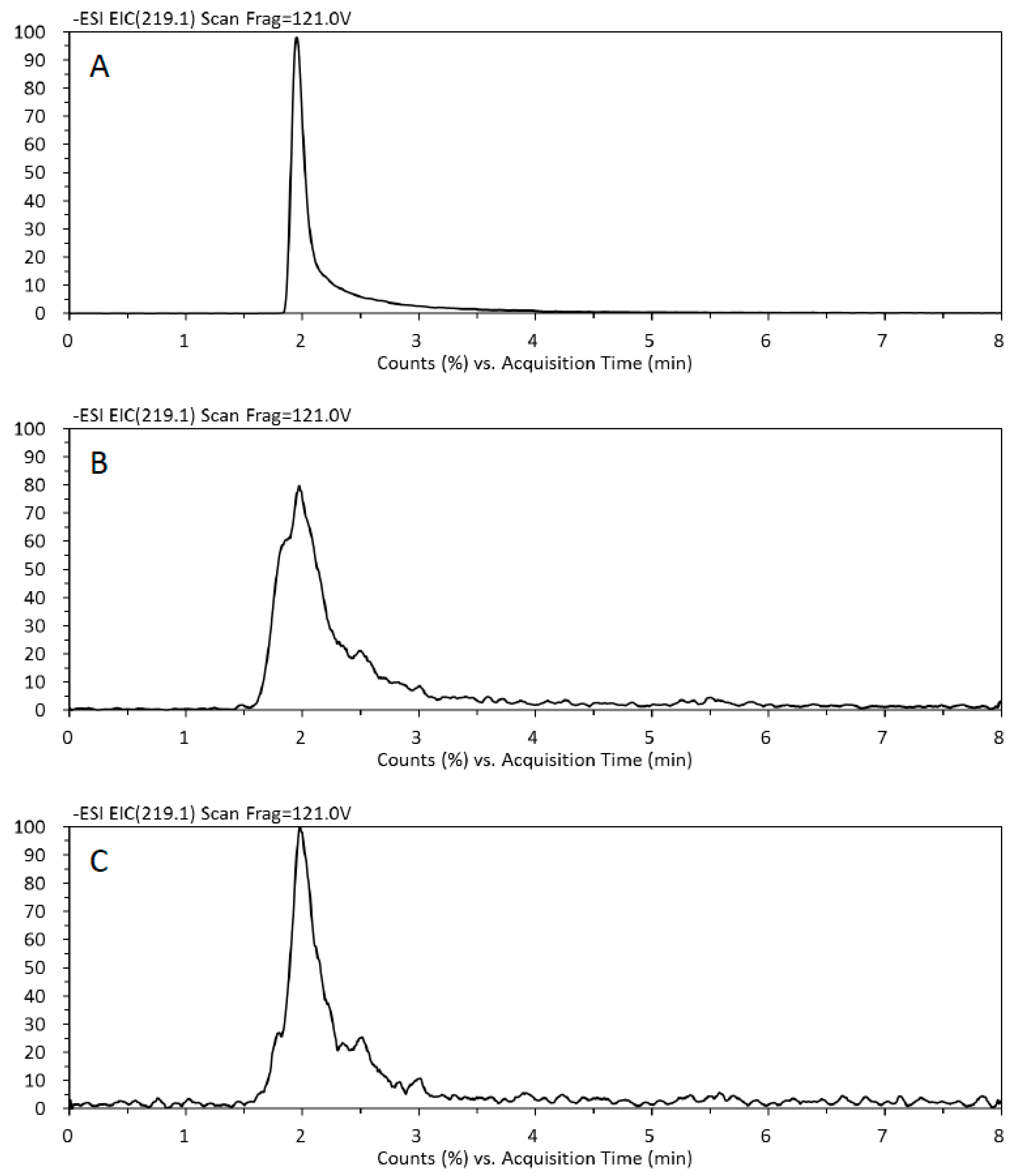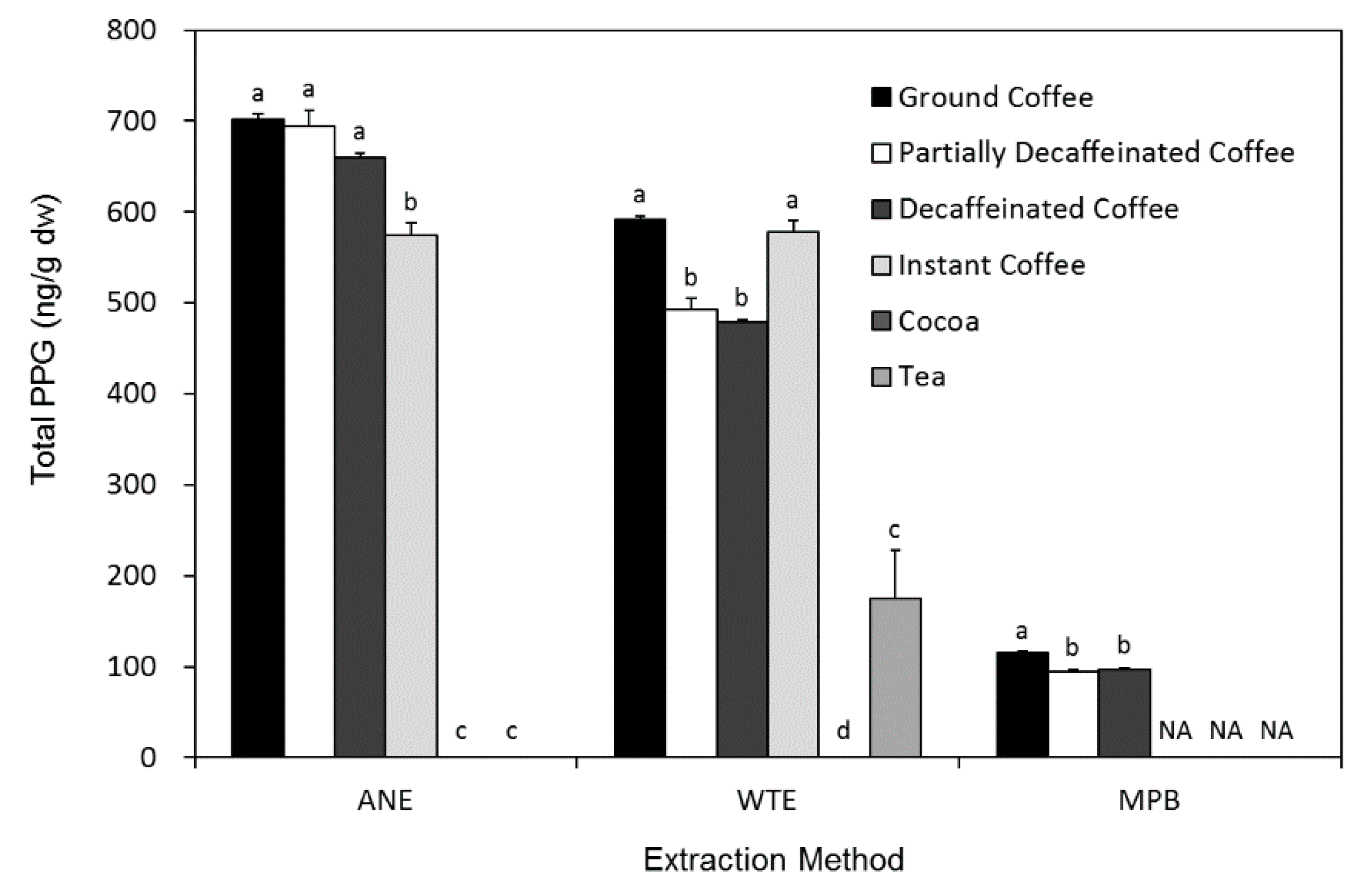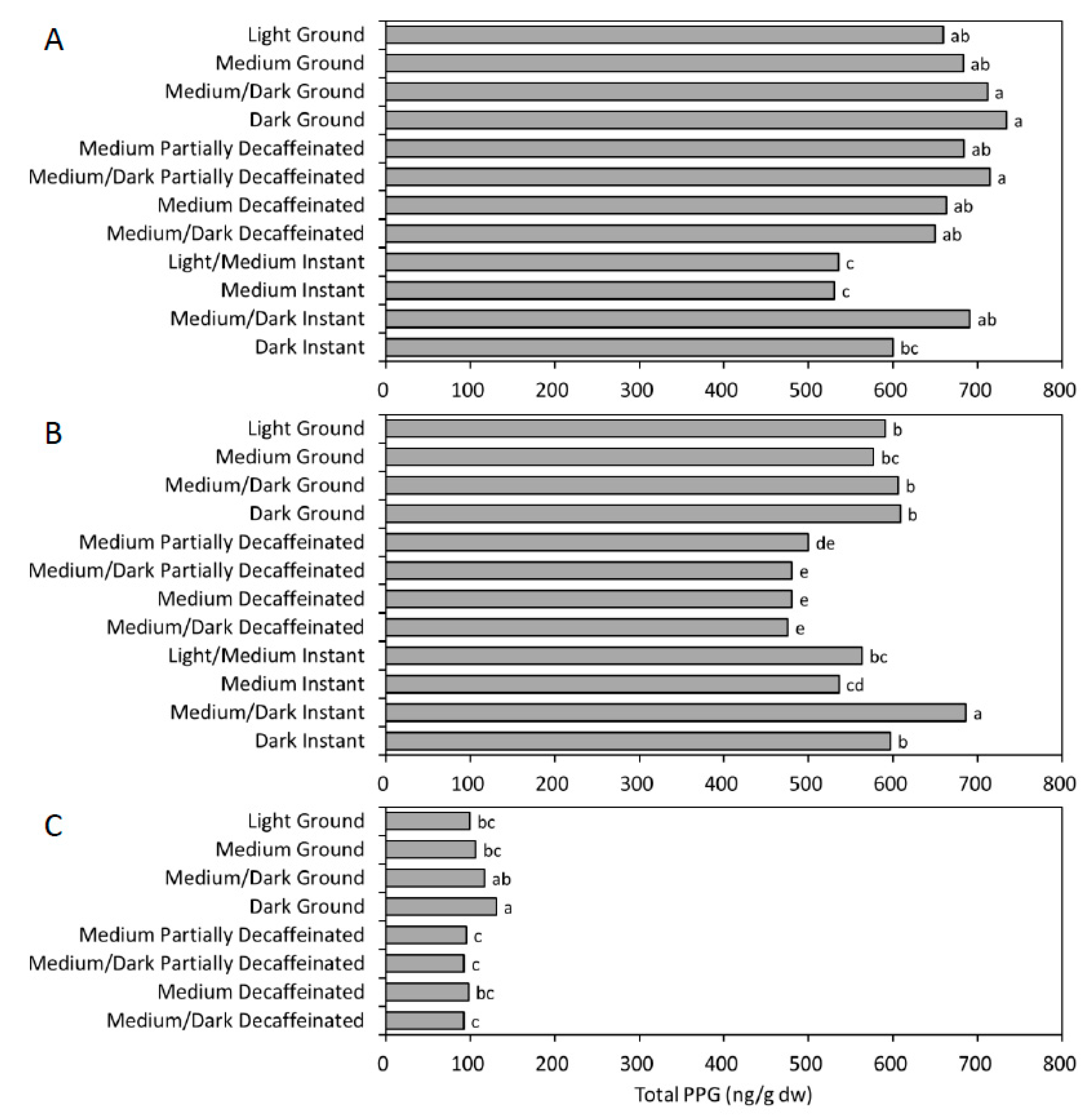A New Approach for Quantifying Purpurogallin in Brewed Beverages Using LC-MS in Combination with Solid Phase Extraction
Abstract
1. Introduction
2. Materials and Methods
2.1. Chemical Reagents and Beverage Materials
2.2. Crude Coffee Extract Preparation
2.3. Solid Phase Extraction (SPE)
2.4. LC-MS
2.5. Quantification
2.6. Recovery
2.7. Statistical Analysis
3. Results and Discussion
3.1. Method Development and Performance
3.2. PPG in Brewed Beverages
4. Conclusions
Author Contributions
Funding
Acknowledgments
Conflicts of Interest
References
- Brezová, V.; Šlebodová, A.; Staško, A. Coffee as a source of antioxidants: An EPR study. Food Chem. 2009, 114, 859–868. [Google Scholar] [CrossRef]
- Shin, J.W.; Wang, J.H.; Kang, J.K.; Son, C.G. Experimental evidence for the protective effects of coffee against liver fibrosis in SD rats. J. Sci. Food Agric. 2010, 90, 450–455. [Google Scholar] [CrossRef] [PubMed]
- Moreira, M.E.D.C.; Pereira, R.G.F.; Dias, D.F.; Gontijo, V.S.; Vilela, F.C.; de Moraes, G.D.O.I.; Giusti-Paiva, A.; dos Santos, M.H. Anti-inflammatory effect of aqueous extracts of roasted and green Coffea arabica L. J. Funct. Foods 2013, 5, 466–474. [Google Scholar] [CrossRef]
- Miller, E.G.; Gonzales, A.P.; Orr, A.M.; Binnie, W.H.; Sunahara, G.I. The anticancer activity of coffee beans. In Caffeinated Beverages: Health Benefits, Physiological Effects, and Chemistry; Parliment, T.H., Ho, C.-T., Schieberle, P., Eds.; American Chemical Society: Washington, DC, USA, 2000; Volume 754, pp. 56–63. [Google Scholar]
- Bonita, J.S.; Mandarano, M.; Shuta, D.; Vinson, J. Coffee and cardiovascular disease: In vitro, cellular, animal, and human studies. Pharmacol. Res. 2007, 55, 187–198. [Google Scholar] [CrossRef]
- Bidel, S.; Hu, G.; Tuomilehto, J. Coffee consumption and type 2 diabetes—An extensive review. Cent. Eur. J. Med. 2008, 3, 9–19. [Google Scholar] [CrossRef]
- Schwarz, K.; Bertelsen, G.; Nissen, L.R.; Gardner, P.T.; Heinonen, M.I.; Hopia, A.; Huynh-Ba, T.; Lambelet, P.; McPhail, D.; Skibsted, L.H.; et al. Investigation of plant extracts for the protection of processed foods against lipid oxidation. Comparison of antioxidant assays based on radical scavenging, lipid oxidation and analysis of the principal antioxidant compounds. Eur. Food Res. Technol. 2001, 212, 319–328. [Google Scholar] [CrossRef]
- Celik, E.E.; Gokmen, V.; Fogliano, V. Soluble antioxidant compounds regenerate the antioxidants bound to insoluble parts of foods. J. Agric. Food Chem. 2013, 61, 10329–10334. [Google Scholar] [CrossRef]
- Liu, Y.; Kitts, D.D. Confirmation that the Maillard reaction is the principle contributor to the antioxidant capacity of coffee brews. Food Res. Int. 2011, 44, 2418–2424. [Google Scholar] [CrossRef]
- Pérez-Hernández, L.M.; Chávez-Quiroz, K.; Medina-Juárez, L.Á.; Gámez Meza, N. Phenolic characterization, melanoidins, and antioxidant activity of some commercial coffees from Coffea arabica and Coffea canephora. J. Mex. Chem. Soc. 2012, 56, 430–435. [Google Scholar]
- Ahmed, G.M.; El-Ghamery, H.E.; Samy, M.F. Effect of green and degree of roasted arabic coffee on hyperlipidemia and antioxidant status in diabetic rats. Adv. J. Food Sci. Technol. 2013, 5, 619–626. [Google Scholar] [CrossRef]
- del Castillo, M.D.; Ames, J.M.; Gordon, M.H. Effect of roasting on the antioxidant activity of coffee brews. J. Agric. Food Chem. 2002, 50, 3698–3703. [Google Scholar] [CrossRef] [PubMed]
- Gómez-Ruiz, J.Á.; Ames, J.M.; Leake, D.S. Antioxidant activity and protective effects of green and dark coffee components against human low density lipoprotein oxidation. Eur. Food Res. Technol. 2008, 227, 1017–1024. [Google Scholar] [CrossRef]
- Vignoli, J.A.; Bassoli, D.G.; Benassi, M.T. Antioxidant activity, polyphenols, caffeine and melanoidins in soluble coffee: The influence of processing conditions and raw material. Food Chem. 2011, 124, 863–868. [Google Scholar] [CrossRef]
- Hounsome, N.; Hounsome, B.; Tomos, D.; Edwards-Jones, G. Changes in antioxidant compounds in white cabbage during winter storage. Postharvest Biol. Technol. 2009, 52, 173–179. [Google Scholar] [CrossRef]
- Huang, Y.L.; Tsujita, T.; Tanaka, T.; Matsuo, Y.; Kouno, I.; Li, D.P.; Nonaka, G.I. Triterpene hexahydroxydiphenoyl esters and a quinic acid purpurogallin carbonyl ester from the leaves of Castanopsis fissa. Phytochemistry 2011, 72, 2006–2014. [Google Scholar] [CrossRef] [PubMed]
- Wu, T.W.; Zeng, L.H.; Wu, J.; Carey, D. Purpurogallin—A natural and effective hepatoprotector in vitro and in vivo. Biochem. Cell Biol. 1991, 69, 747–750. [Google Scholar] [CrossRef]
- Jhoo, J.W.; Sang, S.; Wei, G.J.; Lee, T.C.; Rosen, R.T.; Ho, C.T. Enzymatic synthesis of theaflavins and epitheaflavic acid from tea catecechns and their antioxidant activity. J. Food Lipids 2004, 11, 89–103. [Google Scholar] [CrossRef]
- Field, J.A.; Kortekaas, S.; Lettinga, G. The effect of autoxidation on the methanogenic toxicity and anaerobic biodegradability of pyrogallol. Biol. Wastes 1989, 30, 111–121. [Google Scholar] [CrossRef]
- Sang, S.; Lambert, J.D.; Tian, S.; Hong, J.; Hou, Z.; Ryu, J.-H.; Stark, R.E.; Rosen, R.T.; Huang, M.-T.; Yang, C.S.; et al. Enzymatic synthesis of tea theaflavin derivatives and their anti-inflammatory and cytotoxic activities. Bioorg. Med. Chem. 2004, 12, 459–467. [Google Scholar] [CrossRef]
- Wu, T.W.; Zeng, L.H.; Wu, J.; Fung, K.P.; Weisel, R.D.; Hempel, A.; Camerman, N. Molecular structure and antioxidant specificity of purpurogallin in three types of human cardiovascular cells. Biochem. Pharmacol. 1996, 52, 1073–1080. [Google Scholar] [CrossRef]
- Zhao, J. Plant troponoids: Chemistry, biological activity, and biosynthesis. Curr. Med. Chem. 2007, 14, 2597–2621. [Google Scholar] [CrossRef] [PubMed]
- Zhang, S.; Wu, X.; Xiao, Y. Conversion of lignin-derived 3-methoxycatechol to the natural product purpurogallin using bacterial P450 GcoAB and laccase CueO. Appl. Microbiol. Biotechnol. 2022, 106, 593–603. [Google Scholar] [CrossRef] [PubMed]
- Saad-Allah, K.M.; Ragab, G.A. Sulfur nanoparticles mediated improvement of salt tolerance in wheat relates to decreasing oxidative stress and regulating metabolic activity. Physiol. Mol. Biol. Plants 2020, 26, 2209–2223. [Google Scholar] [CrossRef] [PubMed]
- Żwir-Ferenc, A.; Biziuk, M. Solid phase extraction technique—Trends, opportunities and applications. Pol. J. Environ. Stud. 2006, 15, 677–690. [Google Scholar]
- Juhascik, M.P.; Jenkins, A.J. Comparison of liquid/liquid and solid-phase extraction for alkaline drugs. J. Chromatogr. Sci. 2009, 47, 553–557. [Google Scholar] [CrossRef]
- Armbruster, D.A.; Tillman, M.D.; Hubbs, L.M. Limit of detection (LOD)/limit of quantitation (LOQ): Comparison of the empirical and the statistical methods exemplified with GC-MS assays of abused drugs. Clin. Chem. 1994, 40, 1233–1238. [Google Scholar] [CrossRef]
- Poole, C.F. New trends in solid-phase extraction. TrAC-Trends Anal. Chem. 2003, 22, 362–373. [Google Scholar] [CrossRef]
- Kirchner, M.; Saussen, B.; Steen, H.; Steen, J.A.J.; Hamprecht, F.A. AMSRPM: Robust point matching for retention time alignment of LC/MS data with R. J. Stat. Softw. 2007, 18, 1–12. [Google Scholar] [CrossRef][Green Version]
- Budryn, G.; Nebesny, E. Antioxidant properties of Arabica and Robusta coffee extracts prepared under different conditions. Dtsch. Lebensm.-Rundsch. 2008, 104, 69–78. [Google Scholar]
- Rice, F.E.; Hanzawa, T. Quantitative method for determination of peroxidase in milk. J. Ind. Eng. Chem. 1922, 14, 201–202. [Google Scholar] [CrossRef][Green Version]
- Zabrodsky, P.F. Acetonitrile intoxication impact on humoral and cellular immune responses. J. Cardiol. Curr. Res. 2019, 12, 78–80. [Google Scholar] [CrossRef]
- Illy, E.; Navarini, L. Neglected food bubbles: The espresso coffee foam. Food Biophys. 2011, 6, 335–348. [Google Scholar] [CrossRef] [PubMed]
- Stoltze, A.; Masters, K. Recent developments in the manufacture of instant coffee and coffee substitutes. Food Chem. 1979, 4, 31–39. [Google Scholar] [CrossRef]
- Lang, R.; Mueller, C.; Hofmann, T. Development of a stable isotope dilution analysis with liquid chromatography-tandem mass spectrometry detection for the quantitative analysis of di- and trihydroxybenzenes in foods and model systems. J. Agric. Food Chem. 2006, 54, 5755–5762. [Google Scholar] [CrossRef]
- Chin, E.; Miller, K.B.; Payne, M.J.; Hurst, W.J.; Stuart, D.A. Comparison of antioxidant activity and flavanol content of cacao beans processed by modern and traditional Mesoamerican methods. Herit. Sci. 2013, 1, 9. [Google Scholar] [CrossRef]
- Mazor Jolić, S.; Radojčić Redovniković, I.; Marković, K.; Ivanec Šipušić, Đ.; Delonga, K. Changes of phenolic compounds and antioxidant capacity in cocoa beans processing. Int. J. Food Sci. Technol. 2011, 46, 1793–1800. [Google Scholar] [CrossRef]
- Butt, M.S.; Imran, A.; Sharif, M.K.; Ahmad, R.S.; Xiao, H.; Imran, M.; Rsool, H.A. Black tea polyphenols: A mechanistic treatise. Crit. Rev. Food Sci. Nutr. 2014, 54, 1002–1011. [Google Scholar] [CrossRef]
- Chen, N.; Han, B.; Fan, X.; Cai, F.; Ren, F.; Xu, M.; Zhong, J.; Zhang, Y.; Ren, D.; Yi, L. Uncovering the antioxidant characteristics of black tea by coupling in vitro free radical scavenging assay with UHPLC-HRMS analysis. J. Chromatogr. B Anal. Technol. Biomed. Life Sci. 2020, 1145, 122092. [Google Scholar] [CrossRef]




| Elution Mixture (% AN in Water, v/v, 1 mL) | Fractional Elution Rate (%) | Cumulative Elution Rate (%) |
|---|---|---|
| 0 | 0.86 | 0.86 |
| 10 | 0.17 | 1.03 |
| 20 | 0.38 | 1.41 |
| 30 | 15.77 | 17.18 |
| 40 | 60.23 | 77.41 |
| 50 | 17.55 | 94.96 |
| 60 | 3.38 | 98.34 |
| 70 | 0.86 | 99.21 |
| 80 | 0.44 | 99.65 |
| 90 | 0.19 | 99.84 |
| 100 | 0.16 | 100.00 |
Publisher’s Note: MDPI stays neutral with regard to jurisdictional claims in published maps and institutional affiliations. |
© 2022 by the authors. Licensee MDPI, Basel, Switzerland. This article is an open access article distributed under the terms and conditions of the Creative Commons Attribution (CC BY) license (https://creativecommons.org/licenses/by/4.0/).
Share and Cite
Liao, Y.-C.; Kim, T.; Silva, J.L.; Chen, B.-Y. A New Approach for Quantifying Purpurogallin in Brewed Beverages Using LC-MS in Combination with Solid Phase Extraction. Foods 2022, 11, 1429. https://doi.org/10.3390/foods11101429
Liao Y-C, Kim T, Silva JL, Chen B-Y. A New Approach for Quantifying Purpurogallin in Brewed Beverages Using LC-MS in Combination with Solid Phase Extraction. Foods. 2022; 11(10):1429. https://doi.org/10.3390/foods11101429
Chicago/Turabian StyleLiao, Yu-Chen, Taejo Kim, Juan L. Silva, and Bang-Yuan Chen. 2022. "A New Approach for Quantifying Purpurogallin in Brewed Beverages Using LC-MS in Combination with Solid Phase Extraction" Foods 11, no. 10: 1429. https://doi.org/10.3390/foods11101429
APA StyleLiao, Y.-C., Kim, T., Silva, J. L., & Chen, B.-Y. (2022). A New Approach for Quantifying Purpurogallin in Brewed Beverages Using LC-MS in Combination with Solid Phase Extraction. Foods, 11(10), 1429. https://doi.org/10.3390/foods11101429







